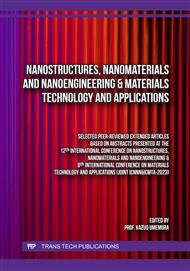[1]
J.D. Mizrahi, R. Surana, J.W. Valle, R.T. Shroff, Pancreatic cancer, The Lancet. 395 (2020) 2008–2020.
DOI: 10.1016/s0140-6736(20)30974-0
Google Scholar
[2]
T. Kamisawa, L.D. Wood, T. Itoi, K. Takaori, Pancreatic cancer, The Lancet. 388 (2016) 73–85.
DOI: 10.1016/s0140-6736(16)00141-0
Google Scholar
[3]
M. Ilic, I. Ilic, Epidemiology of pancreatic cancer, World J Gastroenterol. 22 (2016) 9694–9705.
Google Scholar
[4]
J. Kleeff, M. Korc, M. Apte, C. La Vecchia, C.D. Johnson, A. V. Biankin, R.E. Neale, M. Tempero, D.A. Tuveson, R.H. Hruban, J.P. Neoptolemos, Pancreatic cancer, Nat Rev Dis Primers. 2 (2016) 1–23.
DOI: 10.1038/nrdp.2016.22
Google Scholar
[5]
Cancer Statistics for the UK, (n.d.). https://www.cancerresearchuk.org/health-professional/cancer-statistics-for-the-uk (accessed August 2, 2023).
Google Scholar
[6]
P.S. Sushma, G.P. Nagaraju, Pancreatic Cancer Resistance to Gemcitabine, Breaking Tolerance to Pancreatic Cancer Unresponsiveness to Chemotherapy. (2019) 45–56.
DOI: 10.1016/b978-0-12-817661-0.00004-4
Google Scholar
[7]
T.L. Gastroenterology, Editorial Pancreatic cancer : a state of emergency ?, Lancet Gastroenterol Hepatol. 6 (2021) 81.
Google Scholar
[8]
L. Zhou, H. Wang, Y. Li, Stimuli-responsive nanomedicines for overcoming cancer multidrug resistance, Theranostics. 8 (2018) 1059–1074.
DOI: 10.7150/thno.22679
Google Scholar
[9]
M. Filipits, Mechanisms of cancer: Multidrug resistance, Drug Discov Today Dis Mech. 1 (2004) 229–234.
DOI: 10.1016/j.ddmec.2004.10.001
Google Scholar
[10]
M. Saraswathy, S. Gong, Different strategies to overcome multidrug resistance in cancer, Biotechnol Adv. 31 (2013) 1397–1407.
DOI: 10.1016/j.biotechadv.2013.06.004
Google Scholar
[11]
K. Samanta, S. Setua, S. Kumari, M. Jaggi, M.M. Yallapu, S.C. Chauhan, Gemcitabine combination nano therapies for pancreatic cancer, Pharmaceutics. 11 (2019) 1–25.
DOI: 10.3390/pharmaceutics11110574
Google Scholar
[12]
S.L. Chung, M.S.L. Yee, L.W. Hii, W.M. Lim, M.Y. Ho, P.S. Khiew, C.O. Leong, Advances in nanomaterials used in co-delivery of sirna and small molecule drugs for cancer treatment, Nanomaterials. 11 (2021) 1–20.
DOI: 10.3390/nano11102467
Google Scholar
[13]
S. Paroha, J. Verma, R.D. Dubey, R.P. Dewangan, N. Molugulu, R.A. Bapat, P.K. Sahoo, P. Kesharwani, Recent advances and prospects in gemcitabine drug delivery systems, Int J Pharm. 592 (2021) 120043.
DOI: 10.1016/j.ijpharm.2020.120043
Google Scholar
[14]
J. Lu, M. Liong, Z. Li, J.I. Zink, F. Tamanoi, Biocompatibility, biodistribution, and drug-delivery efficiency of mesoporous silica nanoparticles for cancer therapy in animals, Small. 6 (2010) 1794–1805.
DOI: 10.1002/smll.201000538
Google Scholar
[15]
R. Yuvakkumar, V. Elango, V. Rajendran, N. Kannan, High-purity nano silica powder from rice husk using a simple chemical method, J Exp Nanosci. 9 (2014) 272–281.
DOI: 10.1080/17458080.2012.656709
Google Scholar
[16]
F. Ghorbani, A.M. Sanati, M. Maleki, Production of Silica Nanoparticles from Rice Husk as Agricultural Waste by Environmental Friendly Technique, Environmental Studies of Persian Gulf. 2 (2015) 56–65.
Google Scholar
[17]
S. Song, H.B. Cho, H.T. Kim, Surfactant-free synthesis of high surface area silica nanoparticles derived from rice husks by employing the Taguchi approach, Journal of Industrial and Engineering Chemistry. 61 (2018) 281–287.
DOI: 10.1016/j.jiec.2017.12.025
Google Scholar
[18]
Y. He, S. Liang, M. Long, H. Xu, Mesoporous silica nanoparticles as potential carriers for enhanced drug solubility of paclitaxel, Materials Science and Engineering C. 78 (2017) 12–17.
DOI: 10.1016/j.msec.2017.04.049
Google Scholar
[19]
T. Li, S. Shi, S. Goel, X. Shen, X. Xie, Z. Chen, H. Zhang, S. Li, X. Qin, H. Yang, C. Wu, Y. Liu, Recent advancements in mesoporous silica nanoparticles towards therapeutic applications for cancer, Acta Biomater. 89 (2019) 1–13.
DOI: 10.1016/j.actbio.2019.02.031
Google Scholar
[20]
H. Meng, M. Liong, T. Xia, Z. Li, Z. Ji, J.I. Zink, A.E. Nel, Engineered design of mesoporous silica nanoparticles to deliver doxorubicin and p-glycoprotein siRNA to overcome drug resistance in a cancer cell line, ACS Nano. 4 (2010) 4539–4550.
DOI: 10.1021/nn100690m
Google Scholar
[21]
T. Xia, M. Kovochich, M. Liong, H. Meng, S. Kabehie, S. George, J.I. Zink, A.E. Nel, Polyethyleneimine coating enhances the cellular uptake of mesoporous silica nanoparticles and allows safe delivery of siRNA and DNA constructs, ACS Nano. 3 (2009) 3273–3286.
DOI: 10.1021/nn900918w
Google Scholar
[22]
S.P. Hadipour Moghaddam, R. Mohammadpour, H. Ghandehari, In vitro and in vivo evaluation of degradation, toxicity, biodistribution, and clearance of silica nanoparticles as a function of size, porosity, density, and composition, Journal of Controlled Release. 311–312 (2019) 1–15.
DOI: 10.1016/j.jconrel.2019.08.028
Google Scholar
[23]
S. Saroj, S.J. Rajput, Facile development, characterization, and evaluation of novel bicalutamide loaded pH-sensitive mesoporous silica nanoparticles for enhanced prostate cancer therapy, Drug Dev Ind Pharm. 45 (2019) 532–547.
DOI: 10.1080/03639045.2018.1562463
Google Scholar
[24]
J. Lu, M. Liong, J.I. Zink, F. Tamanoi, Mesoporous silica nanoparticles as a delivery system for hydrophobic anticancer drugs, Small. 3 (2007) 1341–1346.
DOI: 10.1002/smll.200700005
Google Scholar
[25]
B. Muñoz, A. Rámila, J. Pérez-Pariente, I. Díaz, M. Vallet-Regí, MCM-41 organic modification as drug delivery rate regulator, Chemistry of Materials. 15 (2003) 500–503.
DOI: 10.1021/cm021217q
Google Scholar
[26]
S.Y. Chen, P.F. Chou, W.K. Chan, H.M. Lin, Preparation and characterization of mesoporous bioactive glass from agricultural waste rice husk for targeted anticancer drug delivery, Ceram Int. 43 (2017) 2239–2245.
DOI: 10.1016/j.ceramint.2016.11.007
Google Scholar
[27]
J. Athinarayanan, V.S. Periasamy, M. Alhazmi, K.A. Alatiah, A.A. Alshatwi, Synthesis of biogenic silica nanoparticles from rice husks for biomedical applications, Ceram Int. 41 (2015) 275–281.
DOI: 10.1016/j.ceramint.2014.08.069
Google Scholar
[28]
K. Saini, R. Bandyopadhyaya, Transferrin-Conjugated Polymer-Coated Mesoporous Silica Nanoparticles Loaded with Gemcitabine for Killing Pancreatic Cancer Cells, ACS Appl Nano Mater. 3 (2020) 229–240.
DOI: 10.1021/acsanm.9b01921
Google Scholar
[29]
Y. Cao, C. Wu, Y. Liu, L. Hu, W. Shang, Z. Gao, N. Xia, Folate functionalized pH-sensitive photothermal therapy traceable hollow mesoporous silica nanoparticles as a targeted drug carrier to improve the antitumor effect of doxorubicin in the hepatoma cell line SMMC-7721, Drug Deliv. 27 (2020) 258–268.
DOI: 10.1080/10717544.2020.1718801
Google Scholar
[30]
I.L. Hsiao, S. Fritsch-Decker, A. Leidner, M. Al-Rawi, V. Hug, S. Diabaté, S.L. Grage, M. Meffert, T. Stoeger, D. Gerthsen, A.S. Ulrich, C.M. Niemeyer, C. Weiss, Biocompatibility of Amine-Functionalized Silica Nanoparticles: The Role of Surface Coverage, Small. 15 (2019) 1–11.
DOI: 10.1002/smll.201805400
Google Scholar



